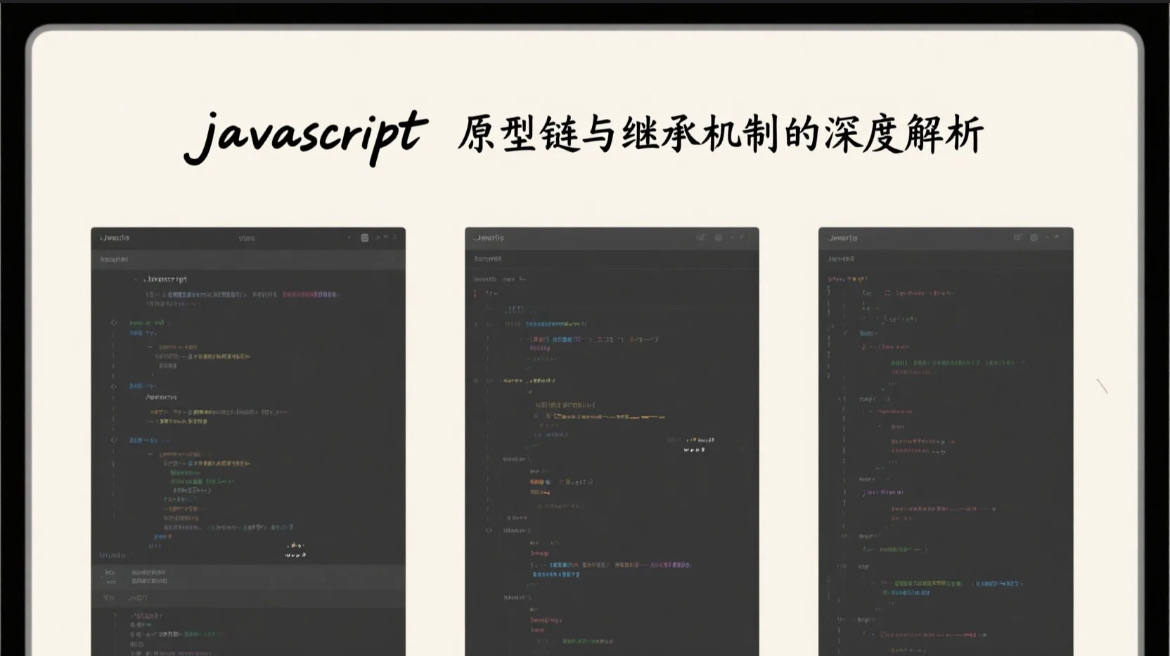前端面试专栏-基础篇:1. javascript 原型链与继承机制的深度解析
JavaScript的原型链与继承机制是其面向对象编程的核心。本文从四个维度深度解析:首先介绍原型概念,每个对象都有[[Prototype]]指向原型对象;其次讲解原型链工作原理,通过多层级继承示例说明属性查找过程;然后详细分析五种继承实现方式,包括原型链继承、构造函数继承、组合继承、寄生组合继承以及ES6的Class语法糖;最后通过流程图阐明构造函数与原型的关系,解释原型链查找规则和共享方法机制
JavaScript的原型链与继承机制是其核心特性之一,理解它们对于掌握这门语言至关重要。以下从多个维度进行深度解析:

一、原型(Prototype)的基本概念
每个对象都有一个内部属性 [[Prototype]](在浏览器中通常暴露为 __proto__),它指向该对象的原型对象。当访问一个对象的属性或方法时,JavaScript首先在对象本身查找,若找不到则沿着原型链向上查找。
const person = {
name: "John",
greet() {
console.log(`Hello, ${this.name}`);
}
};
const student = Object.create(person); // student的原型是person
student.age = 20;
console.log(student.name); // 继承自person: "John"
student.greet(); // 继承自person: "Hello, John"
二、原型链的工作原理
原型链是由多个对象通过 [[Prototype]] 连接而成的层级结构,直到 Object.prototype 为止(其原型为 null)。
示例:多层级继承
const animal = {
eat() { console.log("Eating..."); }
};
const dog = Object.create(animal);
dog.bark = function() { console.log("Woof!"); };
const labrador = Object.create(dog);
labrador.color = "black";
labrador.eat(); // 沿原型链找到animal的eat()
labrador.bark(); // 找到dog的bark()
三、继承的实现方式
1. 原型链继承
通过 Object.create() 或构造函数的 prototype 属性实现。
function Animal() {
this.species = "Animal";
}
function Dog(name) {
this.name = name;
}
Dog.prototype = new Animal(); // Dog继承自Animal
Dog.prototype.constructor = Dog; // 修复constructor指向
const dog = new Dog("Buddy");
console.log(dog.species); // 继承自Animal: "Animal"
2. 构造函数继承
在子类构造函数中调用父类构造函数。
function Animal(name) {
this.name = name;
}
function Dog(name, breed) {
Animal.call(this, name); // 继承实例属性
this.breed = breed;
}
const dog = new Dog("Buddy", "Labrador");
console.log(dog.name); // "Buddy"
3. 组合继承(原型链+构造函数)
结合前两种方式的优点。
function Animal(name) {
this.name = name;
}
Animal.prototype.eat = function() { console.log(`${this.name} is eating`); };
function Dog(name, breed) {
Animal.call(this, name); // 继承实例属性
this.breed = breed;
}
Dog.prototype = Object.create(Animal.prototype); // 继承原型方法
Dog.prototype.constructor = Dog;
const dog = new Dog("Buddy", "Labrador");
dog.eat(); // 继承自原型: "Buddy is eating"
4. 寄生组合继承
优化组合继承中重复调用父类构造函数的问题。
function inheritPrototype(subType, superType) {
const prototype = Object.create(superType.prototype); // 创建原型副本
prototype.constructor = subType; // 修复constructor
subType.prototype = prototype; // 指定子类原型
}
function Animal(name) { this.name = name; }
function Dog(name, breed) {
Animal.call(this, name);
this.breed = breed;
}
inheritPrototype(Dog, Animal); // 核心步骤
5. Class 语法糖(ES6+)
本质是原型链继承的语法糖,更符合面向对象的写法。
class Animal {
constructor(name) {
this.name = name;
}
eat() { console.log(`${this.name} is eating`); }
}
class Dog extends Animal {
constructor(name, breed) {
super(name); // 调用父类构造函数
this.breed = breed;
}
bark() { console.log("Woof!"); }
}
const dog = new Dog("Buddy", "Labrador");
dog.eat(); // 继承自父类: "Buddy is eating"
dog.bark(); // 自身方法: "Woof!"
四、构造函数和原型的关系
在 JavaScript 中,构造函数和原型的关系是实现继承和共享方法的核心机制。以下是详细说明和流程图:
核心关系说明:
- 构造函数:用于创建对象的函数(通过
new调用) - 原型对象:每个构造函数自动关联的
prototype对象 - 实例对象:通过构造函数创建的对象
- 原型链:实例通过
__proto__访问原型对象,形成继承链
关键点解析:
-
构造函数:
- 通过
new关键字调用(如new Person()) - 自动获得
prototype属性(指向原型对象)
- 通过
-
原型对象:
- 存储所有实例共享的方法/属性
- 包含
constructor属性指回构造函数 - 示例:
Person.prototype.sayHello = function() {...}
-
实例对象:
- 通过
new Constructor()创建 - 自动获得
__proto__属性(指向构造函数的prototype) - 优先访问自身属性,找不到时沿原型链查找
- 通过
-
原型链继承:
function Person(name) { this.name = name; // 实例自有属性 } // 共享方法存入原型 Person.prototype.sayHello = function() { console.log(`Hello, ${this.name}!`); }; const alice = new Person('Alice'); alice.sayHello(); // 通过原型链访问
关系流程图详解:
原型链查找规则:
-
访问实例属性时(如
alice.sayHello()):- 先查找实例自身是否有该属性
- 若未找到,通过
__proto__查找原型对象 - 若仍未找到,沿原型链向上查找(直到
Object.prototype)
-
验证方法:
console.log(alice.__proto__ === Person.prototype); // true console.log(Person.prototype.constructor === Person); // true console.log(Object.getPrototypeOf(alice) === Person.prototype); // true
实际应用场景:
- 方法共享:避免每个实例重复创建相同方法,节省内存
- 继承实现:通过
Child.prototype = Object.create(Parent.prototype)建立原型链 - 核心API原理:如数组的
push()方法实际存储在Array.prototype中
重要提示:现代 JavaScript 推荐使用
class语法(本质仍是原型机制),但理解构造函数与原型的关系是掌握 JS 面向对象的基础。
五、原型链的性能与陷阱
- 属性查找效率:多层级原型链会影响属性查找性能。
- 引用类型共享问题:原型上的引用类型属性会被所有实例共享。
function Person() {} Person.prototype.hobbies = []; // 引用类型 const p1 = new Person(); const p2 = new Person(); p1.hobbies.push("reading"); console.log(p2.hobbies); // ["reading"](意外共享) - 修改原型的影响:动态修改原型会影响所有已创建的实例。
六、关键方法与属性
Object.create(proto):创建一个新对象,指定其原型为proto。Object.getPrototypeOf(obj):获取对象的原型。obj.hasOwnProperty(key):检查属性是否属于对象自身(而非原型)。instanceof运算符:检查对象是否属于某个类或构造函数的实例。const dog = new Dog(); console.log(dog instanceof Dog); // true console.log(dog instanceof Animal); // true(通过原型链)
六、总结
JavaScript 的继承基于原型链,核心是通过 [[Prototype]] 连接对象。ES6 的 class 和 extends 语法简化了继承的写法,但底层仍然依赖原型机制。理解原型链是掌握 JavaScript 面向对象编程的关键,能帮助你避免常见的继承陷阱并编写出更高效的代码。
更多推荐
 已为社区贡献12条内容
已为社区贡献12条内容









所有评论(0)